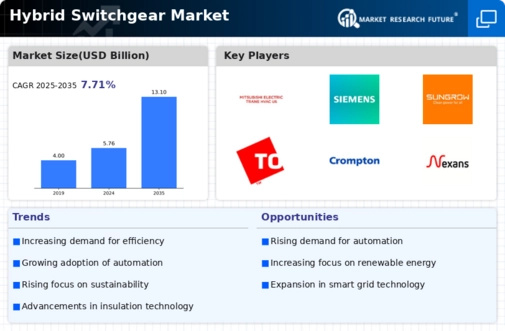Top Industry Leaders in the Hybrid Switchgear Market
*Disclaimer: List of key companies in no particular order
Top listed companies in the Hybrid Switchgear industry are:
ABB (Switzerland), GE (US), Mitsubishi Electric (Japan), Siemens (Germany), Toshiba Corporation (Japan), Skipperseil (India), TGOOD (Colombia), Schneider Electric (France), Hitachi (Japan), CG (India), L&T (India), Chint (China), Hyosung (South Korea), Taikai Power Engineering (China), and Capchem Electricals Pvt. Ltd (India)
Competitive Landscape of Hybrid Switchgear Market: A Battle for Efficiency and Sustainability
The hybrid switchgear market, a burgeoning segment within the broader power distribution industry, is witnessing a fierce competitive landscape driven by the convergence of technological advancements and the global push for renewable energy integration. Established players jostle for market share while new entrants seek to carve their niche through innovative offerings. To unravel this dynamic picture, let's delve into the key strategies, market share analysis factors, and emerging trends shaping the competitive scenario.
Key Player Strategies:
Established powerhouses: Global giants like ABB, Siemens, and Schneider Electric leverage their extensive experience, robust R&D capabilities, and strong brand recognition to maintain dominant positions. They prioritize strategic partnerships, acquisitions, and product portfolio diversification to cater to various voltage levels, applications, and regional demands. For example, ABB's recent collaboration with Hitachi ABB Power Grids focuses on developing advanced digital solutions for hybrid switchgear, while Siemens emphasizes modularity and flexibility in its offerings.
Regional players: Companies like TGOOD Global (China) and Ningbo Tianan Group (China) are making significant strides in their home markets, capitalizing on cost-competitiveness and local market knowledge. They are increasingly partnering with global players to access advanced technologies and expand their reach.
Emerging contenders: Startups and smaller firms are disrupting the market with niche solutions focused on specific applications or voltage ranges. They often employ agile development cycles and prioritize digital integration to address evolving customer needs. For instance, Enbala Power (US) specializes in hybrid switchgear for microgrids and distributed generation, while Eaton Corp. (US) targets the low-voltage segment with compact and intelligent solutions.
Market Share Analysis Factors:
Technology leadership: Companies with cutting-edge technologies like vacuum circuit interrupters, gas-insulated switchgear, and digital control systems command a premium and attract customers seeking reliability, efficiency, and smart grid integration.
Geographical presence: A robust global footprint with production facilities and service networks across key regions like Europe, Asia Pacific, and North America is crucial for capturing diverse market opportunities.
Product portfolio breadth: Offering a wide range of solutions catering to various voltage levels (up to 72.5 kV, 72.5-245 kV, and above), installation types (onshore and offshore), and applications (infrastructure, transportation, and industrial) broadens reach and caters to diverse customer needs.
Sustainability focus: Companies aligning their offerings with energy efficiency goals and environmental regulations, for example, by reducing greenhouse gas emissions and incorporating recycled materials, gain favor with environmentally conscious customers and investors.
New and Emerging Trends:
Digitalization: Integration of artificial intelligence, cloud computing, and advanced analytics into hybrid switchgear is enabling predictive maintenance, optimized operation, and enhanced grid resilience.
Modularization: Building block approach allows for flexibility, scalability, and easier customization to meet specific project requirements.
Cybersecurity: As digitalization increases, robust cybersecurity measures become paramount to protect against cyberattacks and ensure grid stability.
Sustainability focus: Development of eco-friendly materials, reduced energy consumption, and end-of-life recycling solutions are becoming increasingly important differentiators.
Overall Competitive Scenario:
The hybrid switchgear market is characterized by intense competition with diverse players employing a range of strategies. While established players leverage existing strengths, regional players and niche players are making inroads through strategic partnerships, cost-competitiveness, and innovative solutions. Technology leadership, geographical presence, product portfolio breadth, and sustainability focus remain key factors for market share analysis. New and emerging trends like digitalization, modularization, and cybersecurity are reshaping the competitive landscape, demanding continuous adaptation and innovation from all players. The future of the hybrid switchgear market promises to be exciting, with constant evolution driven by the interplay of technological advancements, sustainability pressures, and the ever-changing energy landscape.
Latest Company Updates:
ABB (Switzerland): Launched the UniGear HybridMax in July 2023, featuring increased compactness and optimized safety measures for medium-voltage applications (source: ABB press release)
GE (US): Announced the PowerPass MV switchgear in September 2023, with hybrid technology options for enhanced reliability and reduced footprint (source: GE Power blog)
Siemens (Germany): Unveiled the SENTRON Hybrid in April 2023, targeting distributed generation and renewable energy integration with its hybrid air-vacuum technology (source: Siemens website)
Mitsubishi Electric (Japan): Showcased the VACOSOLAR MV hybrid switchgear for solar power plants at Intersolar Europe in May 2023 (source: Mitsubishi Electric news)
Toshiba Corporation (Japan): Introduced the GZ-series GIS-hybrid switchgear in March 2023, emphasizing space-saving design and eco-friendliness (source: Toshiba press release)

